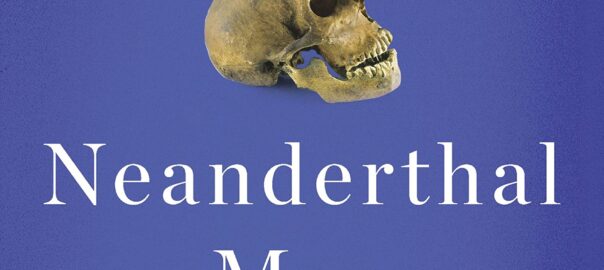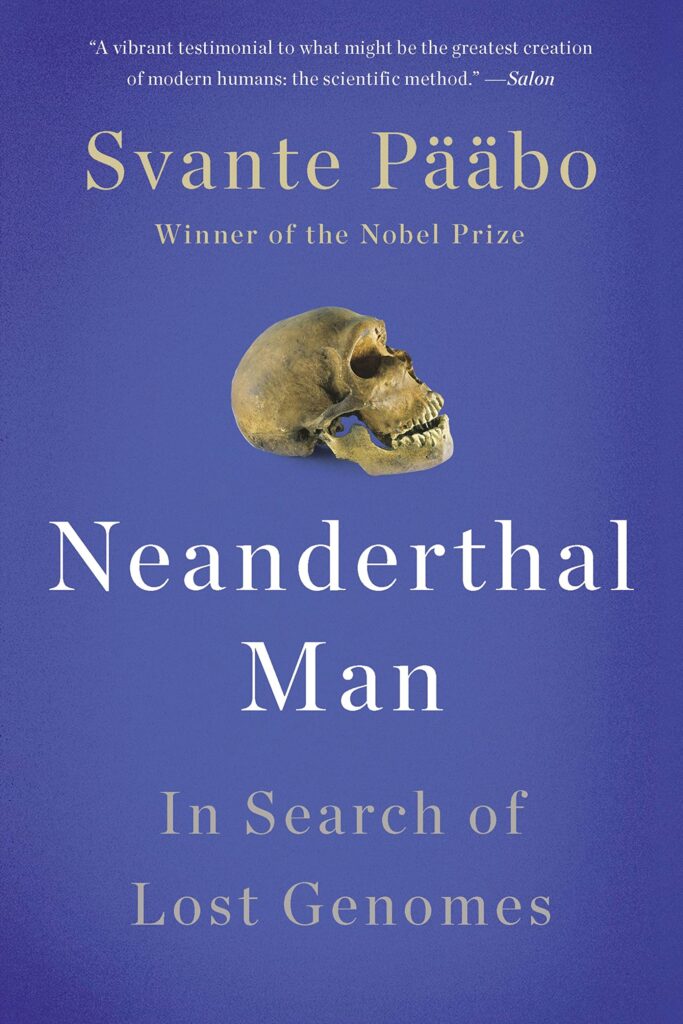Neanderthals, our nearest cousin species, finally died out soon after 40,000 years ago. How are we related to them? When did we first branch off from them? Did we interbreed with them? How big is the genetic gap between our two species? Physical Anthropologist and Archeologists could only guess, for until the advent of paleogenetics in the 1980s, there was no way to tell clearly. It then took until 2010 to find out, for it was not until then that the whole Neanderthal genome was published.
Svante Pääbo, whose team answered these questions, describes how the genetic make-up of ancient fossils was extracted and unraveled. He also tells how the Neanderthal genome compares with that of humans. In line with accepted opinion, this showed that our two species had diverged sometime between 440,000 and 270,000 years ago, at a time when we had both been living in Africa. But surprisingly, it showed that the humans who left Africa about 50,000 years ago interbred with Neanderthals, probably in the Middle East, as they moved on toward Europe and Asia. It also showed that traces of that interbreeding have been diluted since then, so there is now only about 2-5% of Neanderthal DNA left in the humans who had came out of Africa. There are no Neanderthal genes to be found in Africans.
A reason why some Neanderthal genes may have remained in Eurasians was suggested by Peter Parham, the world’s foremost expert on the major histocompatibility complex (MHC), which is involved with fighting infection (and organ rejection). As Neanderthals had inhabited Eurasia some 200,000 years before humans arrived, their repertoire of MHC gene variants might have become adapted to fighting diseases local to that area, and absent from Africa. Thus modern non-African humans would benefit from this advantage and their specialized Neanderthal genes would have survived.
As for how close are we to the Neanderthals, the final conclusion of the population geneticists is that there are 78 differences (maybe up to 220), out of 20,000 proteins encoded in the genome. Sadly, with our present lack of knowledge, there is little understanding of what these genetic differences mean in terms of their expression in biochemistry, structure or behavior. For we still only have an inkling of how a particular genetic sequence comes to affect how an animal is formed and how it behaves.
However, this book is more than a story of scientific exploration and achievement. It is also a scientific autobiography, like James Watson’s “The Double Helix”, the 1968 best seller that described Crick and Watson’s discovery of the structure of DNA in 1953. Just like Watson’s book, it is written like a thriller, telling a story of 25 years of development, during which enormous technical advances have reduced the cost of analyzing a genome by 3,000,000 times, and speeded it up so much that analysis of whole genomes has become commonplace.
In telling how the Neanderthal genome was sequenced, Pääbo starts in 1983, when the very first sequence of ancient DNA was isolated by Professor Allan Wilson’s team at Berkeley. They had sequenced a sample taken from the 100 year old hide of an extinct cousin of the Zebra, the Quagga. Soon after that, Pääbo, then a PhD medical student in Uppsala, decided to moonlight outside the area of this PhD and try to extract some DNA from the mummy of an Egyptian girl who had died 2,300 years ago. In 1985, he published a paper showing how he had isolated the first sample of DNA from an ancient human. He sent this to this paper to Professor Wilson, without a covering letter, and to his surprise, received a letter from Wilson, asking whether the professor could work in his laboratory during a coming sabbatical. As a student, and not having a laboratory, he was flattered and had to explain the situation, but then was emboldened to ask Wilson, in turn, whether he could work under him in California. Wilson consented and so, having decided to switch from medicine to genetics, and after a stint of work in Zurich, he arrived in Berkeley a year or so later.
The Berkeley lab was very successful, and they extracted mitochondrial DNA (mtDNA) from many historic animals, ranging from 100 year old Kangaroo rats to the extinct Thylacine marsupial wolf from Australia, related to the Tasmanian devil. This showed that wolf-like animals had evolved not just twice, but three times; that evolution was, in a sense, repeatable. The paper describing this was published in Nature, with Pääbo as the lead author for the first time.
In 1990, at the age of 35, he was offered a full professorship at the zoological department in Munich, where he led a small team which honed their techniques of the extraction of DNA from the remains of extinct animals, such as 50,000 year old Siberian mammoths, 25,000 year old horse ancestors, and the giant sloth from South America. Their constant foe was contamination and this was to be a continuing problem. But after five years of hard work they had established reliable methods for studying zoological specimens. Finally, in 1996, they achieved what Pääbo had longed to do for some time. They were give a 3.5 gram piece of bone from one of the original Neanderthals, specimens found in the Neander valley, now stored in Bonn. From this they analyzed part of the mitochondrial DNA of Neanderthals for the first time.
Partly as a result of this, he was asked to be one of the leaders of the projected (and now famous) Max Plank Institute for Evolutionary Anthropology, which ultimately was established in Leipzig. This was specifically located in the old East Germany, because it was felt that this area of the newly unified Germany should be seeded with new, vibrant institutions, open to the world, to make up for the stultifying restrictions it had suffered in the past. The stated goal of the Institute is to discover what had set humans on an evolutionary track so different from other primates.
In Leipzig he was given a wonderful opportunity to help specify a new building for the Institute, with special clean rooms, essential for avoiding cross-contamination of ancient samples by modern human DNA, and in 2002, he began work, together with the four distinguished colleagues who headed up the other departments: the American psychologist Mike Tomascello, the Swiss primatologist Cristophe Boesch and the British comparative linguist Bernard Comrie. They were eventually joined by the French paleontologist Jean Jaques Hublin and over 400 others who work with them.
The key to his success has been not only his skill in forming a group of collaborators at the institute who complemented each other, but also in forging relationships with technology companies outside who were developing new machines in the burgeoning field of genetic analysis. His enthusiastic personality and deep knowledge of the field allowed him to reach out to researchers from other disciplines across the world who could contribute to the analysis of ancient DNA. Antediluvian DNA, they called it.
In 2006 he realized that the technology for analyzing DNA sequences had progressed to such an extent that, if he used the new genetic sequencing machines from 454 Life Sciences, a biotechnology company based in Branford, Connecticut, it would be possible to reconstruct the entire Neanderthal genome. All he needed was money and good Neanderthal bones. He made an estimate of the cost and was delighted to received 5 million euros to fund the project; more than four year’s funding for his whole department.
Finding the bones was more difficult. The best ones were from the Vindija cave in Croatia, and it needed lengthy diplomacy to persuade the Croatian authorities to part with some small fragments. But at last they got them and realized that they could produce 3 billion nucleotides, the paired chemical strands within the double helix, of Neanderthal DNA from just three 40,000 year old bone fragments. Four years later, after many setbacks and more technical advances, they published the whole nuclear genome in a paper in Science magazine on the 7th May 2010. A paper weighed down with 174 pages of supplementary material.
Pääbo describes the problems, the techniques, the biochemistry, the machines, the computers and the software required in great detail. And these are fascinating for those with some technical knowledge. But, even for the technically naïve, the complexity, patience, determination, skill, and depth of knowledge is apparent and very impressive.
Another aspect which comes through in his story is the way that this kind of research is organized, funded and carried out on an international scale. He describes the interaction and competition between laboratories across the world, not only by means of publication, but also through conferences, visits and interchange of staff from different continents. In this case there were Swedes, Germans, Italians, French, South Africans, Britons, Americans, Croatians and others, some of them in Leipzig and others in America, Sweden, Croatia and Britain. Such work depends so much on specialized knowledge and skill that no single nation can produce the human resources needed to carry it out. But also, the people in the field form a close international community, distinct from those in other fields.
Pääbo’s is a fascinating story of discovery, but it is also a story that shows that chance can be as important as focus and skill; a story dependent on interests outside his initial specialization. For, had he not been fascinated by Egyptology, due to a visit to Egypt as a boy, he would not have been tempted to moonlight in his medical research laboratory, trying to extract DNA from a mummified girl. Had he not known a museum curator who had a talent for friendship and thus knew certain curators in East Germany, he would not have been able to get samples from the Egyptian girl’s mummy, which was stored in a dusty Berlin museum. Had he not been working at that particular time, he would not have learned of the Polymerase Chain Reaction (PCR)1, a process which produces a vast number of copies of a specific piece of DNA invented in 1983, and his work would have been impossible. So, maybe these coincidences should not be thought of as chance, but rather that they are the essential ingredients for the success of such a project; that for anything to happen, there needed to be an alignment of particular people, at a particular place and at a particular time.
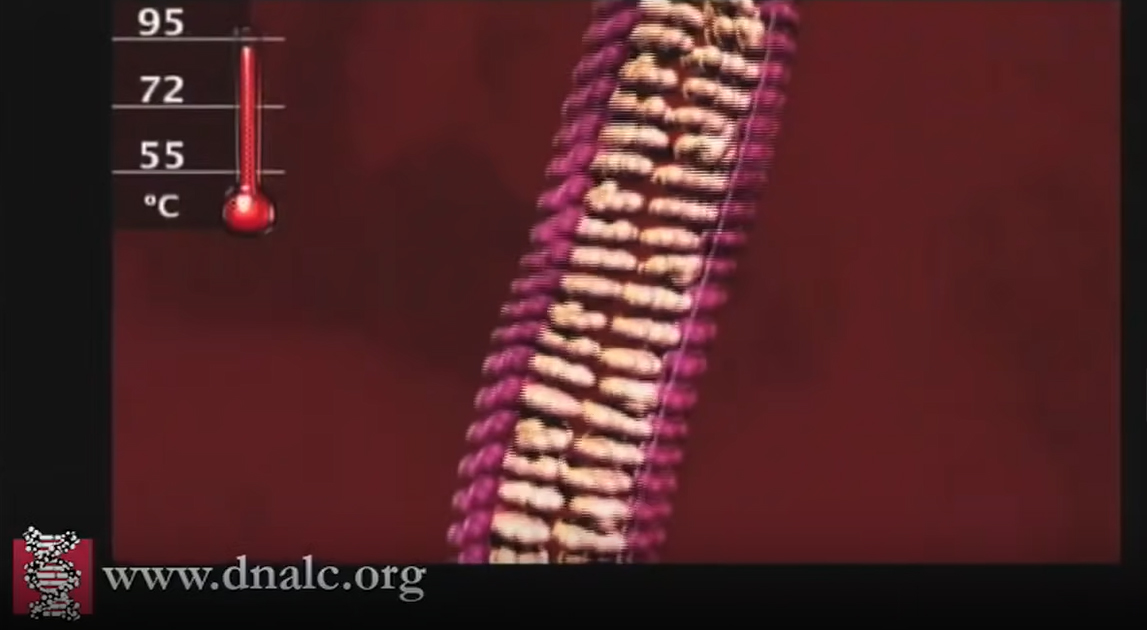

Pääbo finishes the book with the discovery of yet another human cousin, the Denisovan man, some remains of whom were found in a Siberian cave in 2009. (The cave had once been occupied by a hermit called Dennis). Although only the tip of a finger and a tooth have been found, this was enough for his team to assemble a complete mitochondrial genome. This showed that the Denisovans differed from modern humans in an average of 385 nucleotide positions, while the Neanderthals differed in only 202. This means that they branched off from the Human/Neanderthal stem about 1,000,000 years ago, while Humans and Neanderthals had split off from one another less than 500,000 years ago. This discovery shows what a fertile and fast-moving field this is, and that we can confidently expect more surprises in the years to come.
Indeed, as the field of paleogenetics is so young, there is continuing argument between those who study bones and those who study genes, and differences of opinion about the exact date of speciation.

The Age of Empathy and The Bonobo and the Atheist
Frans de Waal
Both reciprocity and empathy – the two pillars upon which morality is built – are found in bonobos, apes and other social animals. But only humans are able to “abstract” the value and extend the behavioral constraints of “one-on-one” morality to the larger society, including strangers.
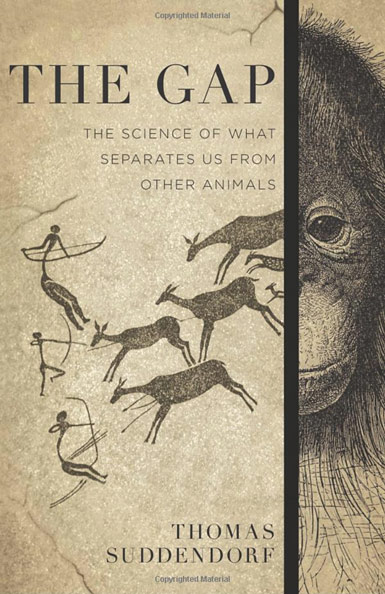
The Gap
The Science of What Separates Us from Other Animals
Thomas Suddendorf
A leading research psychologist concludes that our abilities surpass those of animals because our minds evolved two overarching qualities.
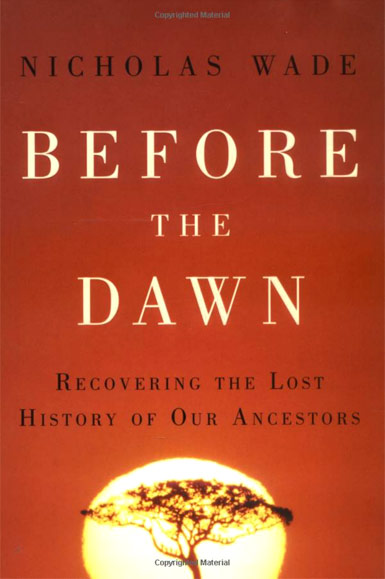
Before the Dawn
Recovering the Lost History of Our Ancestors
Nicholas Wade
New York Times science writer explores humanity’s origins as revealed by the latest genetic science.
In the series: Discovering Our Distant Ancestors
- Genetics and Human Evolution
- Our Nearest Relatives: Bonobos and Chimpanzees
- Our Hominid Predecessors
- She Has Her Mother’s Laugh
- The Evolution of Human Morality: The Age of Empathy and The Bonobo and the Atheist
- The Gap: The Science of What Separates Us from Other Animals
- Before the Dawn: New details of human evolution revealed
Related articles:
Further Reading »
External Stories and Videos
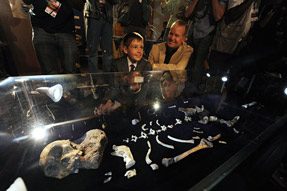
New Fossils May Redraw Human Ancestry
Nicholas Wade, The New York Times:
An apelike creature with human features, whose fossil bones were discovered in a South African cave, is being greeted by paleoanthropologists as a likely watershed in the understanding of human evolution.
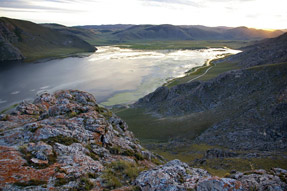
24,000-Year-Old Body Shows Kinship to Europeans and American Indians
Nicholas Wade, New York Times
The genome of a young boy buried at Mal’ta near Lake Baikal in eastern Siberia some 24,000 years ago has turned out to hold two surprises for anthropologists.
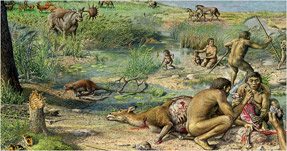
Clues of Britain’s First Humans
Nicholas Wade, New York Times
The genome of a young boy buried at Mal’ta near Lake Baikal in eastern Siberia some 24,000 years ago has turned out to hold two surprises for anthropologists.

Study Finds Humans Still Evolving, and Quickly
Karen Kaplan, Los Angeles Times
The pace of human evolution has been increasing at a rate 100 times faster than when our ancestors first began spreading through Europe, Asia, and Africa 40,000 years ago.

